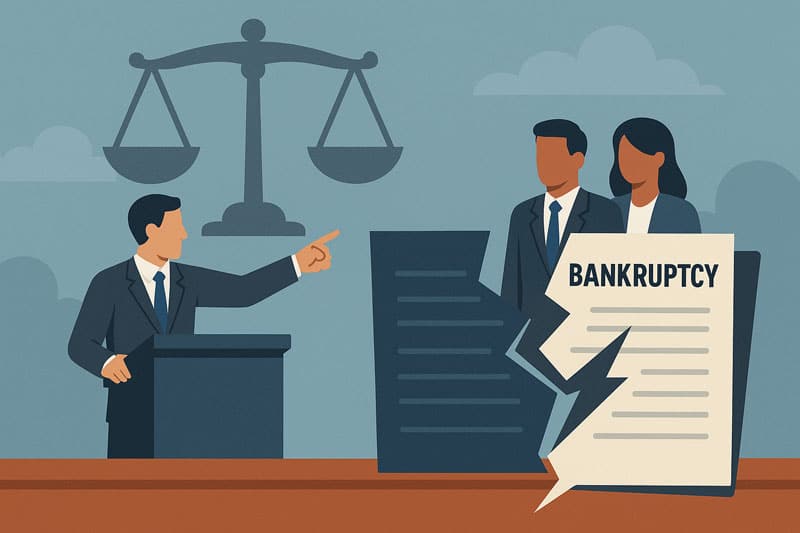
If you don’t know what an adversary proceeding in bankruptcy is, you’re far from alone. Only a small percentage of Los Angeles bankruptcy filers file or face an adversary proceeding. For example, in 2024 there were 25,936 bankruptcy cases filed in the U.S. Bankruptcy Court for the Central District of California, and just 709 adversary proceedings. In other words, adversaries were filed in fewer than 3% of cases.
The rate of adversary proceedings has picked up in 2025, though. In the Los Angeles Division, a total of 289 adversary proceedings were filed in 2024. As of mid-July, the count for 2025 stands at 313.
Here’s what you need to know about adversary proceedings, when they may play a role in your bankruptcy case, and why these proceedings may be more important than ever.
What Is an Adversary Proceeding in Bankruptcy?
An adversary proceeding is like a lawsuit, except that it happens within your bankruptcy case. Some types of adversary proceedings are filed by the bankruptcy petitioner, and others by a creditor or even the bankruptcy trustee. Some common examples of adversary proceedings in consumer bankruptcy cases include:
- A creditor filing an adversary proceeding asking the court to determine that a debt the bankruptcy filer has listed is not dischargeable
- A bankruptcy petitioner filing an adversary proceeding asking the court to determine that a lien against the debtor’s property is not valid
- A bankruptcy trustee filing an adversary proceeding to unwind a transfer of property that took place before the bankruptcy case was filed
How Does an Adversary Proceeding Work?
The party initiating an adversary proceeding files a complaint with the bankruptcy court. The adversary proceeding is assigned its own case number. The complaint is served on the responding party just as a lawsuit would be, and then the other party has an opportunity to respond.
Unless the proceeding is resolved by agreement, the court will hold a hearing on the complaint and the judge will rule on the issue.
There are substantive and procedural requirements similar to those in a civil lawsuit, and the process is more complex than the core bankruptcy filing. So, it’s best to work with an experienced Los Angeles bankruptcy lawyer to file an adversary proceeding, or if a creditor or the bankruptcy trustee has filed one in your case.
What’s New With Adversary Proceedings?
Technically, nothing has changed. Adversary proceedings are still used for the same types of matters they always have been, and the process is still the same. But adversary proceedings are ticking upward and getting more attention due to guidelines issued during the Biden administration that took some time to gain traction.
New Rules for Student Loans in Bankruptcy
Since 1998, it’s been difficult to discharge student loans in bankruptcy. Federal educational loans and federally guaranteed educational loans are typically only dischargeable if the bankruptcy filer can prove that being required to repay the loans would cause an undue hardship. The process for making that case is an adversary proceeding.
Historically, establishing undue hardship has been an uphill battle, to the point that most bankruptcy petitioners across 20+ years didn’t even bother to try to discharge student loan debt.
In 2022, new guidance to Department of Justice (DOJ) lawyers lowered the bar for establishing undue hardship for many borrowers. But the change didn’t get a lot of press, and many student loan borrowers weren’t even aware that they might suddenly qualify for student loan discharge. Even bankruptcy lawyers weren’t sure exactly how the new guidance would play out. So, many people filing for bankruptcy still didn’t even try to discharge their student debt. Few pursued bankruptcy specifically to try to get out from under student loans.
That is slowly changing as success stories pile up.
Success Rates for Student Loan Discharge are High
Most bankruptcy filers still aren’t pursuing student loan discharge, for a variety of reasons. However, the numbers are mounting, and as they do it’s becoming clear that reducing or eliminating student debt in bankruptcy is far more realistic today than it was just a few years ago.
The most recent report from the DOJ, published in mid-2024, said 98% of adversary proceedings to discharge student loan debt had resulted in full or partial discharge of student loans. And, the DOJ noted, the number of successful discharges was increasing.
Considering Pursuing a Discharge of Student Loan Debt?
If you’re struggling with student loan debt and want to explore the possibility of discharging the debt in bankruptcy, the best time to act is now. In part, that’s because collection activity on student loan debt recently restarted, and interest rates are set to jump for many borrowers who were enrolled in the SAVE program. But there’s another reason to act quickly. This borrower-friendly guidance is just that–not a change in the law or a court ruling, but a memo issued during the previous presidential administration. That guidance could be revoked at any time, particularly in view of the many recent decisions that have been harmful to student loan debtors.
To learn more about whether you may qualify for a discharge of some or all of your student loan debt, schedule a free consultation with one of our experienced Los Angeles bankruptcy attorneys. Call us right now at 877-439-9717 or fill out our contact form to get started.
